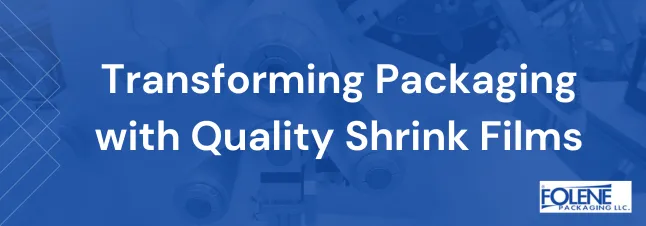
Environmentalists and government agencies are anxious about how much CO2 we put into the atmosphere. Second only to China, North America emits 18% of global emissions. Energy production, manufacture, and packaging play a large part in this.
Carbon Dioxide (CO2) emissions damage natural habitats, among other negatives. It is time to ask, “What is decarbonization?” While a Pew Research Center survey found that 74% of Americans want to reduce the consequences of climate change, how many of us actually know what decarbonization is? A decarbonization definition is crucial for understanding how industries can shift towards sustainable practices to reduce their carbon emissions.
What is Decarbonization?
Decarbonization is the reduction or elimination of carbon dioxide emissions into the atmosphere. It means making a positive effort to reduce or eliminate carbon dioxide emissions. By reducing the CO2 we produce and gradually counteracting existing CO2 surpluses, we can limit the adverse effects of carbonization on the atmosphere.
Awareness is always the first step. So, by asking what decarbonization is, we will be a little closer to reducing the quantity of carbon dioxide around the world. The Net Zero Coalition is an unbelievable reality, with 196 countries united as decarbonization partners under the Paris Agreement to fight climate change.
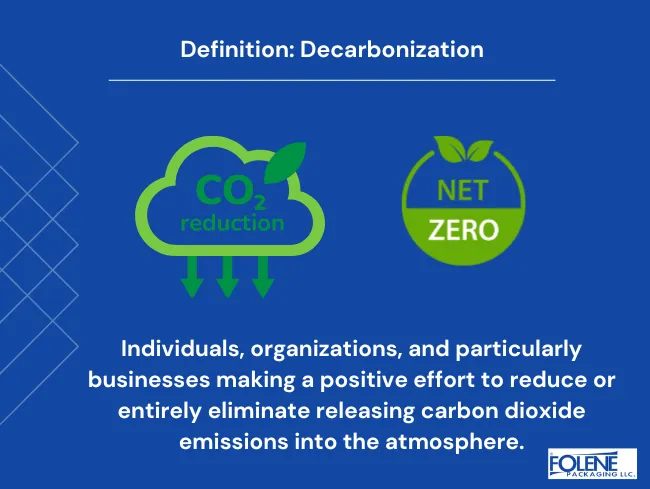
Why is Decarbonization Important?
Besides problems caused by breathing unhealthy, oxygen-depleted air, CO2 warms the globe. Scientists often discuss what decarbonization is in relation to climate change. With one ounce of CO2 produced for each ounce of polyethylene (PET) manufactured, U.S. suppliers (who back in 2018 produced 35.7 million tons of plastics) clearly bear some responsibility.
Plastic manufacturers and suppliers who rely on plastic packaging want to produce less carbon dioxide. They are part of the 61% of Americans who worry that climate change is negatively affecting their local community. They also want solutions that help products and produce stay fresher longer since fitting food also contributes to carbonization. What is decarbonization if not a strategy for achieving sustainability?
How High is CO2 Pollution These Days?
CO2 is a greenhouse gas released into the atmosphere. A continuous monitor of CO2 in the atmosphere shows that the current CO2 level (at the time of publishing) is 421.69 ppm, up 3.44 ppm from a year ago. This figure should motivate us to decarbonize our businesses and environment.
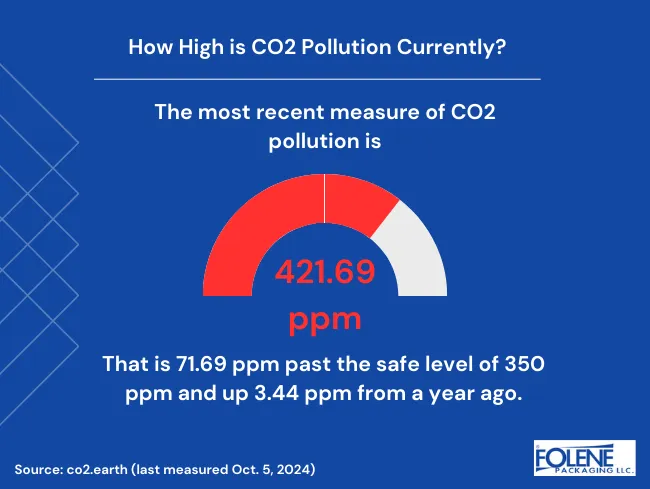
What Are the Main Decarbonization Goals?
GHG emissions reductions make up the overall plan. Using the 1800s to set pre-industrial levels of CO2 and the global temperature, in the U.N. Climate Change Conference, the main decarbonization goals (set forth in the 2015 Paris Agreement) in reducing carbon emissions:
Global warming will not be above 1.5°C
Following 2025, global greenhouse gas emissions will only get lower.
We will reduce greenhouse gas emissions by 43% by 2030.
By 2050, the U.N. aims to have decarbonized transport systems and stop uncontrolled global warming.
What Are the 4 Main Decarbonization Strategies?
The United Nations’ global decarbonization strategy establishes decarbonization strategies to reduce global GHG emissions. Decarbonizing an industry, country, business, or building can be achieved through the choices people make as industrial leaders, suppliers, and consumers.
The main strategies to lower emissions will bring about industrial decarbonization:
Electrification of energy: Avoid using fossil fuels, such as natural gas, for transportation and manufacture and use net-zero energy, such as renewable-sourced carbon-free electricity and other low-carbon fuels. This will reduce emissions from industrial sources and fossil fuel power plants.
Carbon capture and storage: CO2 emissions from industrial operations and generating power are collected and transported by ship or pipeline to deep underground geological formations dedicated to long-term CO2 storage.
Increase energy efficiency: Avoid energy consumption wherever possible. Improving efficiency will still reach production goals. Examples of energy efficiency improvement are better insulation against heat loss during production and using energy-efficient appliances.
Renewable energy: Support renewable energy development. Renewable energy sources should power unavoidable energy consumption. Use electricity produced from renewable resources. Wind and solar power are two examples of low-carbon energy sources.
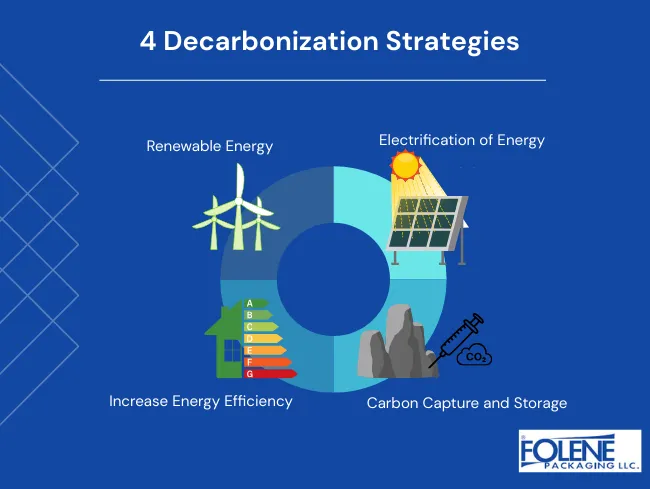
Carbon offsetting (such as by soil carbon storage) is a different strategy from decarbonization. Learn more about carbon offsetting in our post about carbon-neutral shipping It is essential to understand what decarbonization is as part of the larger goal to address climate issues.
Why Is It Important To Make a Decarbonization Plan?
U.N. recommendations for reaching net zero carbon emissions by 2050 aim to achieve the goals set in the Paris Agreement, protect biodiversity, prevent damage from climate change, and rescue the planet.
6 Steps to Making a Decarbonization Strategy
Build a decarbonization strategy and then optimize it at set intervals as you meet guidelines and regulations and your own goals in reducing your company’s carbon footprint:
Grow awareness of your business’s obligation in decarbonization and the decision to implement a decarbonization strategy.
Examine the essential climate considerations that your business needs to incorporate.
Decide how to cover the expense of any changes you will need to make, such as the cost of hiring a decarbonization consulting company. Contact relevant investors and stakeholders.
Set up the most appropriate methods for reporting to satisfy data requirements and regulations. Use data-tracking to measure your business’s progress and share successes with your stakeholders and customers.
Transition to low-carbon production. Plan for and continue your supply chain decarbonization efforts.
Overcome sector-specific challenges and increase efficiency by partnering with decarbonization partners and industry peers.
Join leaders such as Disney, Delta, General Motors, Microsoft, and Shell (which are among Sustainability Magazine’s top 10) and Johnson& Johnson, Tesla, Moody’s, H.P., and Colgate-Palmolive (which are among Forbes’ top 100) as they journey towards net zero.
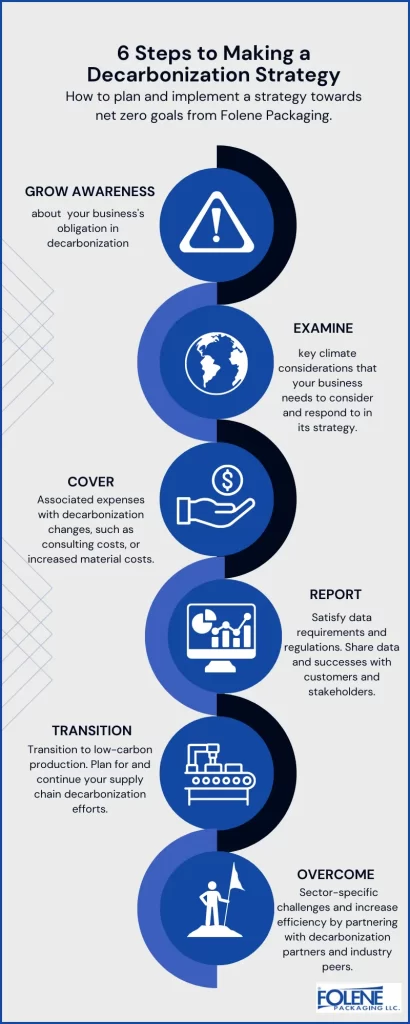
How Folene Packaging Supports Decarbonization Goals and Helps Reduce Global Carbon Emissions
Folene Packaging is committed to decarbonization from several angles. Since its inception, Folene Packaging has been implementing sustainable supply chain practices. Our raw materials are produced in Europe and shipped concisely. We then convert our premium polyolefin films in the USA and ship them within a few days. This saves energy by preventing the need to transport the finished product from the Far East over several weeks.
Folene is proud to offer Flxtite® AP-6 among our range of films. This shrink film shrinks at a lower temperature than other films, allowing it to shrink much more quickly than other film types and retain fast-sealing properties. Regular polyolefin shrink film has a temperature-shrink range of 250 to 350 degrees F., but Flxtite® AP-6 shrinks at around 215-250 degrees F. Packaging with Flxtite® AP-6 means businesses avoid using PVC films (which produce dangerous gases when heated and burnt, noticeable by the noxious odor produced when using PVC). Companies that switch from PVC to polyolefin shrink wrap immediately notice an improvement in the odor. This is good for individuals and great for decarbonization. Of course, using polyolefin shrink film supports decarbonization technology as it preserves produce and food packaging for longer and prevents the development of greenhouse gases and carbonization from rotting produce and food waste.
Learn more about Flxtite® AP-6, an ideal shrink film for most display packaging and multipacks. You’ll never have to ask, “What is decarbonization?” again.
